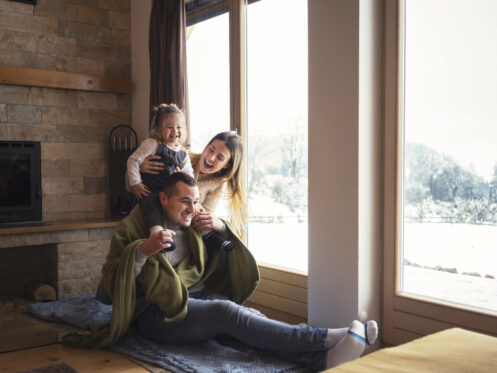Christmas trees are among the most iconic and recognizable symbols of the holiday season. Decorating a Christmas tree is a popular way to launch festivities and create a cozy and welcoming home. According to the National Christmas Tree Association (NCTA), Americans purchase well over 60 million Christmas trees each year. However, the presence of a Christmas tree can also impact the quality of your indoor air. Both real and artificial trees have potential drawbacks. A look at the specific ways that Christmas trees affect indoor air can help you take proactive steps to protect your home.
What Is Indoor Air Quality?
Indoor air quality (IAQ) is the condition or caliber of air as it relates to the health and comfort of a building’s occupants. According to the Environmental Protection Agency (EPA), U.S. residents spend up to 90% of their time indoors. In particular, Americans may spend an increased amount of time indoors during the winter due to weather conditions and traditional holiday gatherings. Unfortunately, this can expose individuals to sources of indoor pollutants. Types of pollutants found indoors can include allergens, mold, or volatile organic compounds (VOCs).
Allergens are particles, contaminants, or substances that trigger an allergic reaction. Types of airborne allergens include pollen, fungal spores, dust, house mites, and animal dander. Indoor allergens can circulate in the air but may also remain on carpets and furnishings for months. Volatile organic compounds (VOCs) are toxic chemicals that evaporate at room temperature. VOCs occur in various parts of nature, but they are also by-products of ingredients in man-made or synthetic items. Found in everything from paint to air fresheners and cleaning products, VOCs can increase the risk of long-term illnesses.
How Do Real Christmas Trees Affect Indoor Air Quality?
Real Christmas trees are part of indoor holiday traditions that date back to the 1500s. In fact, many historians link Christmas trees to celebratory pine and fir trees that predate the Christian era. Many families associate real trees with a lush, beautiful appearance and a refreshing evergreen scent. A real tree is also biodegradable and recyclable. However, real Christmas trees are also a major source of airborne allergens.
According to the EPA, the pleasant pine scent from your Christmas tree is actually a release of volatile organic compounds (VOCs). In arboreal terms, these conifer VOCs are known as “pinenes.” High concentrations of pinenes give Christmas trees their trademark scent. For people with respiratory problems and allergies, pinenes can irritate the nasal cavity and also cause headaches. Other symptoms include watery eyes, sneezing, coughing, or congestion.
In addition, a real Christmas tree is also a potential source of mold and other biological contaminants. A large tree is essentially an ecosystem for entire microbial communities. The average tree may contain over 50 species of pathogenic mold spores. According to a study from the American College of Allergy Asthma and Immunology (ACAAI), the number of household mold spores can increase exponentially in only two weeks after installing a real Christmas tree. These trees can also contain outside dirt, pollen, mildew, outside gnats or pests, or other fungi.
How Do Artificial Christmas Trees Affect Indoor Air Quality?
While some families turn to artificial Christmas trees to lower the risk of organic compounds or mold, fake trees can also impact indoor air quality. Artificial trees are made of non-biodegradable plastic. Most trees consist of flexible polyvinyl chloride (PVC). This synthetic substance is the world’s third-most widely produced petroleum-derived polymer. Unfortunately, this flexible plastic polymer can release toxins and VOCs. This is especially true if the plastic has been compacted or stored in a tight space for some time. Experts recommended unboxing an artificial tree outdoors each year and letting it air out before setting it back up in your home.
In addition to plastic polymer, some artificial trees also contain flame retardants and phthalates. Some flame-retardant molecules can act as neurotoxins with long-term exposure. Even worse, other studies have shown that phthalates can act as endocrine disruptors. This means that their chemical composition can interfere with your body’s hormonal production. Phthalates are also “forever chemicals” that do not break down but can remain in the environment for hundreds of years. Finally, artificial Christmas trees can also attract large amounts of static dust. If left uncleaned, this dust can exacerbate allergies each year.
What Can I Do to Improve Indoor Air Quality?
Both real and artificial trees can compromise indoor air quality and increase the risk of allergies and other airborne illnesses. Some professionals refer to this increased risk of illness as “Christmas tree syndrome.” Fortunately, there are ways to lower this risk and improve indoor air quality. First, you can consult with a home services company to install an air purifier within the home. Consider upgrading to a whole-house purifier or whole-home air filtration to remove existing contaminants and toxins from indoor air.
You can also take preventative steps when buying trees and setting them up in your home. Many Christmas tree farms have a policy of harvesting trees and then stacking them tightly in refrigerated trailers. Unfortunately, this method allows mold and other contaminants to flourish. Instead of buying a pre-cut tree that possibly harbors tons of mold spores, consider visiting a local tree farm to cut your own fresh one. Before bringing a real tree indoors, use a leaf blower outside to remove pollen particles trapped in the branches. A mechanical tree shaker can help remove pine needles and dust. Another option is to spray the tree completely with a vegetable and fruit wash and let it dry fully outside before bringing it indoors. You can also use a combination of bleach and water to wipe down the trunk. After Christmas, recycle the tree to reduce mold exposure and protect the environment.
There are similar preventative measures for artificial trees. Wipe down artificial trees and decorations with a dust cloth to remove allergens. In addition, wash any tree skirts, table runners, or similar holiday linens in hot, soapy water. You can use this same process to clean holiday decorations before storing them for next year. Remember to store decorations in sealed plastic containers instead of cardboard boxes. Unfortunately, cardboard may encourage the growth of mold, mildew, or similar allergens. This is especially true if you store the decorations in non-ventilated spaces like garages or attics. Some families also choose to skip the tree and traditional decorations every other year and use holiday tapestries or nativity scenes instead.
Finally, you can schedule an HVAC inspection to ensure your home has the right upgrades for winter. For example, an HVAC professional can install high-efficiency particulate air (HEPA) to help remove airborne contaminants. In addition to whole-home HEPA filters, HVAC technicians can recommend cleaning vacuums with HEPA filters and high MERV ratings. MERV stands for “minimum efficiency reporting value” and refers to how effectively a filter can remove particles. The higher the MERV rating, the more particles the filter can catch and help keep your home clean.
Get Help Today
Christmas trees can have an unintended impact on indoor air quality. But with the right help from the experts, there is no need to panic. Environmental Heating & Air Solutions offers indoor air quality services for homes in Roseville and Northern California. We provide duct cleaning, filter installation, and air ventilation services. Our technicians also conduct winter carbon monoxide detection and air sealing services. You deserve to breathe clean air. Contact Environmental Heating & Air Solutions today for all indoor air quality needs.

